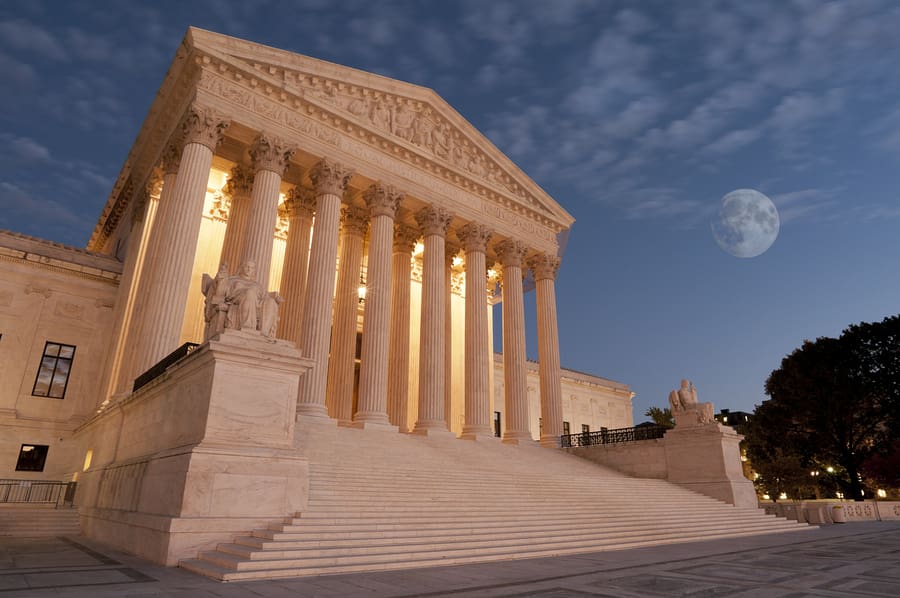The United States Supreme Court has set an official conference date of December 13 to decide if the High Court will hear Snope v. Brown, a case directly challenging Maryland’s assault weapon ban, addressing whether states can legally ban semi-automatic rifles such as the AR-15, commonly owned and used by law-abiding citizens. While some say this case has the potential to redefine the future of firearm legislation across the nation, the fact that arguments are so deeply rooted in precedent set by earlier landmark Second Amendment decisions such as District of Columbia v. Heller (2008) and New York State Rifle & Pistol Association v. Bruen (2022) makes one wonder, haven’t we been here before?
It has been over a decade and a half since Heller affirmed that firearms “in common use” for lawful purposes cannot be banned, a principle further solidified just over two years ago when Bruen held that firearm laws must be consistent with the nation’s historical tradition of firearm regulation, rejecting the use of “means-end” tests by future courts when evaluating firearm restrictions. These precedents are central, and one could say redundant, to the arguments outlined in Snope v. Brown, however, that has not stopped states like Maryland from enacting laws that fly in the face of previous SCOTUS rulings.
I feel SCOTUS should simply hold lawmakers in contempt of court, and wish they would, yet here we are yet again being forced to re-litigate inalienable rights concisely recognized by the Constitution as the government uses our own tax dollars to fight us at every level of the judicial system. But I digress.
Thus far, Maryland’s strategy has been to delay the case for as long as possible. The case was originally petitioned to the Supreme Court on August 23, 2024, giving the state 30 days to reply. As September 23 approached, Maryland requested a 30-day extension, which the the High Court granted, pushing the date their response must be submitted to October 23. Unsurprisingly, as that date neared, the state again attempted to delay the matter, telling SCOTUS that they are so heavily encumbered with Second Amendment litigation that legal personnel could not be allocated. Thankfully the Supreme Court put a stop to Maryland’s shenanigans, instructing the state that it would receive only a couple more weeks by which to submit its reply brief.
That reply brief was submitted on November 12, to which plaintiff’s attorneys responded on November 25. The Supreme Court acted expeditiously, taking less than 24 hours to distribute the case for conference, fast-tracking that date to December 13.
The AR-15, known as America’s rifle, is central to the case due to its widespread ownership and use for sporting, hunting and self-defense. These legal uses combined with statistics showing that rifles are among the least used firearms in crimes demonstrate that Maryland’s ban is not only unconstitutional but also ineffective and nonsensical.
The importance of the Supreme Court providing a definitive ruling on the matter stems from what many feel are inconsistencies between SCOTUS precedent and lower court rulings which frequently uphold bans on AR-15s and similar firearms. By sidestepping the “common use” standard established in Heller, instead employing contradictory reasoning such as deeming these firearms excessively dangerous or primarily suited for military use, inconsistency seems more like a symptom of the real problem. Federal and state governments are actively and with forethought attempting to erode Second Amendment rights regardless of the High Court’s rulings. We all know what happens to citizens who knowingly and willingly act against a judge’s order, yet somehow those same rules do not apply to lawmakers, proving again, rules for thee, not for me.
The Supreme Court’s duty here is not to rewrite the law, but to ensure lower courts adhere to existing precedent as it has been decided clearly in multiple cases. But that feels like we are clarifying clarifications over and over with no end in sight. Some have referred to Snope v. Brown as a defining moment in the shifting political and legal landscape of American gun rights. I hope it will be as Maryland’s arguments are extremely weak. The state continues to argue that AR-15s are not protected by the Constitution, a tired and defeated notion that, if pressed at the SCOTUS level, would lead to a clear win for gun rights advocates.
If SCOTUS overturns Maryland’s ban, the precedent may secure gun rights for generations, however, if the Justices decline to take the case, states could become emboldened, pushing for stricter bans and fueling additional polarization. A decision that defends the Second Amendment rights of Americans will extend far beyond the state of Maryland, as such a ruling would apply to bans in states such as California, New York and New Jersey.
With the conference date of Friday, December 13, a decision as to whether SCOTUS will hear the case could come as soon as the following Monday. If the Justices elect to take the case, a final ruling is expected by June 2025. There is no doubt that Americans who recognize and respect the Constitution and the values our country was founded upon will be waiting on the edge of their seats as this is a fight for the future of the Second Amendment itself, however, it concerns me a great deal that we could receive yet another affirmation of our rights that may simply be ignored as blue states have already demonstrated. A solution needs teeth that provide consequences if the ruling is not adhered to by the state, as such is expected of its citizens.





It sounds like Maryland’s law (banning military-style semi-auto rifles) is relying upon the U.S. Supreme Court’s dicta in the Heller decision about “dangerous and unusual weapons”. If that is Maryland’s argument, then they have opened Pandora’s box on what constitutes “dangerous and unusual” and Plaintiffs should seize that opportunity. Plaintiffs could then argue that the U.S. Supreme Court should not only recognize AR-15 and AK-47 rifles, they should also recognize magazines with capacities of dozens of rounds as well as the cockamamie classification of “short-barreled” rifles and shotguns. Heck, they could even throw in suppressors while they are at it.
Now THAT–a U.S. Supreme Court decision which ensures unfettered access to acquire and own military style semi-auto rifles, short-barreled rifles and shotguns, magazines with capacities of dozens of rounds, and suppressors–would be utterly and totally epic. And it would be just dessert for totalitarian states like Maryland.
We don’t care what the Judges say, we do what we want and nobody stops us.
Sue away it’s the taxpayers money anyway.
We like spending the tax payers money.
State laws are above federal laws.
New York and California leads the way.
Prior restraint is the essence of tyranny. Population psychosis makes tyranny seem desirable, creating conditions wherein tyrants prosper…
How about the CA rifle ban that passed in 1989? Or all the other CA rifle bans passed years later that added to the original 1989 law. Justice delayed is justice denied. The DC handgun ban lasted from 1976-2008. When it was overturned you still couldn’t go out and legally buy a handgun since there are no DC FFL dealers. Then DC council passed a law only allowing CA approved handguns and the process to purchase one of these cost hundreds of dollars in registration fees and training classes plus months of waiting. So glad I moved out of the District in 92’. Maybe one of the SCOTUS judges who actually lives in DC should try to legally buy a handgun or AR (which is also illegal). (I would bet all the Justices actually live in MD or VA)
“(I would bet all the Justices actually live in MD or VA)”
I would bet they don’t. But it wouldn’t surprise me very much if doing research on where they live startled Google.
I agree that a ruling is needed, and your article explains why. My only point of disagreement is this : “We all know what happens to citizens who knowingly and willingly act against a judge’s order, yet somehow those same rules do not apply to lawmakers, proving again, rules for thee, not for me.” This is legal nonsense. Injunctions apply only to parties to an action. Citizens not party to an action are not affected, and the same is true of legislators; only the State (or other governmental entity) is subject to the injunction, but legislators are not. Moreover, Legislators, and for a number of very good reasons I won’t detail here, are statutorily exempt from law liability for laws that they pass. Yes, there are “rules for thee but not for me laws” such as those exempting themsleves from the effect of laws passed, but this is not one of them, since legislators cannot own AWs either.
Mark N.,
While your legal commentary is completely accurate, the fact remains that state governments are passing laws and enforcing them which obviously defies U.S. Supreme Court rulings.
Look at it this way. Suppose I kept honking my car horn all night long, resulting in neighbors filing a public nuisance lawsuit against me, resulting in the court ordering me to stop honking my car horn all night long–and the very next night I start honking my car horn again. At that point I am openly defying the court order or lawsuit decision (whichever is applicable) and the court has legitimate authority to hold me accountable for violating the order/decision against me. That is what we are talking about when we say that members of a state government who pass a law which openly violates a U.S. Supreme Court decision are openly defying the court–and the courts should have legitimate authority to levy significant sanctions (including fines and prison time) on those politicians for their defiance.
For reference my commentary above is simply about wrong-versus-right in plain English. It is not commentary on the status of how the law is. Rather, it is a commentary on how the law should be.
Your example does not apply to legislators. They pass laws, they do not enforce them. They must be free from litigation as to their legislative activities; were it otherwise, anyone who disagreed with any law could sue, and it would take no time at all before legislative activity came to a complete halt. Chaos and anarchy would ensue. It is enough that the State itself is potentially liable in state courts as the attorneys fees for litigating such cases is immense.
1908 Supreme Court decision in Ex Parte Young—allowed people threatened with harm by an unconstitutional state law to sue state officials in federal court for an injunction against the law’s enforcement. It may not be direct punishment but it can supply some relief.
Thus case is much older than the article implies. Originally called Bianchi, this case bounced around the US district and appeals courts for years, and was one of the four cases USSC sent back for review as wrongly decided after the 2022 Bruin decision. Bianchi finally said fuggit and moved out of MD, Snopes was next man up.
If a few of the several appellate judges that refuse to follow the SCOTUS decisions would be barred from hearing these cases, or be reassigned to the undesirable court dockets, it might change a few attitudes. Which in turn may likely result in these frivolous laws being dumped upon their initial litigation, which in turn would discourage legislative bodies from trying to ram this crap through the courts.
“The five-member Okeechobee, Florida city council and Police Chief Donald Hagan may each be forced to pay $5,000 personally – without using taxpayer dollars – for violating Florida’s powerful preemption statute, which only allows the state legislature to regulate firearms.”
https://saf.org/florida-officials-who-banned-guns-prior-to-hurricane-may-soon-pay-for-their-error/
Too bad we can’t stick the lower court judges with something like this…
The whole idea of banning “military-style” (emphasis on the “style”) firearms is ridiculous, absurd. Style has absolutely nothing to do with how safe or “dangerous” a gun or a car is. It’s like the state saying they’re going to reduce street-racing by banning “race-car-style” cars and then using those overly broad and vague words (“race-car-style”) to ban any car that’s red (like their fear of black guns!) or has a rear spoiler, aluminum wheels, dual exhaust, bright-tip exhaust, tilt steering wheel, adjustable pedals, bucket seats, reclining seats, or a “semi-automatic” transmission (paddle shifters like race cars have)!
Liberal anti-gun states with unlimited taxpayer moneys, know they will lose in court but, the idea is to drain the funds or bankrupt the pro-gun rights groups.
The Second Amendment was written for the express purpose of We The People bearing weapons of war.
It puts no limits on what is and what isn’t.
Assault weapons ban, magazine restrictions, NFA, GCA, 4473 government permission, all of it unconstitutional.
Who protects the constitution?
We do, not a judge, not a court.
The Supreme court decisions have a strong historical precedent of acknowledging the purpose of the 2nd Amendment is to preserve the rights of citizens to defend themselves from government tyranny. This is why discussions about the type of weaponry is a distraction from the provisions of the Constitution that prohibit interfering with the citizen’s rights to bear arms free of government infringement. If you don’t agree with the Constitution amend it. Don’t undermine the law of the land through subversive tactics.
I was trained on the M-16 on my way to Vietnam; The Civilian Models are not assault weapons, Military Models are! Civilian Models are simply semi-automatic weapons, no more no less. To compare the two would like comparing a real super Corvette to one with a 6 Cyl engine in it! For example, a Military Grade M-16 (aka) AR-15 can convert from automatic fire to machine gun firing, Military Grade is capable of launching a grenade about 100 yards, Military Grade weapons have a quick release to address weapon jamming etc. Machine guns have been illegal since Al Capone days, if only advocates of gun control had served their country in the Military they would have an understanding which many fail to embrace!
Some of your terminology is stunning off. An M-16 is a true assault weapon in that it is capable of both semi-auto AND full-auto fire. That is the only place where an M-16 differs from a civilian AR-15. Grenade launching is not a function of the M-16 itself, but an attached grenade launcher. Which, by the way, the current crop of civilian AR-15s can be fitted with. And I have zero idea what you are referring to when you talk about a “quick release to address jamming”. Civilian and military AR-style rifle are identical in that regard to that ability.
Well you sure told him…
The internet is like the assault weapon version for the 1st amendment. All these blue states banning any type of firearm is a disgrace especially in light they make exceptions for so called law enforcement…I be for a ban for any if it first applied to the military and cops, until then no!
I do like the idea of the supreme court holding the politicians who passed these KNOWINGLY unconstitutional laws in contempt.
At the very least, they should direct the state to pay all court costs under the “frivolous litigation” statute.
What about the yark machine, what’s the permitting process there. Limits on shoulder-fired missiles, WTF??? YYYYAAAAAAARK-K-K-K LOL
Roberts is a weenie. He has no stomach for fight.
Comments are closed.